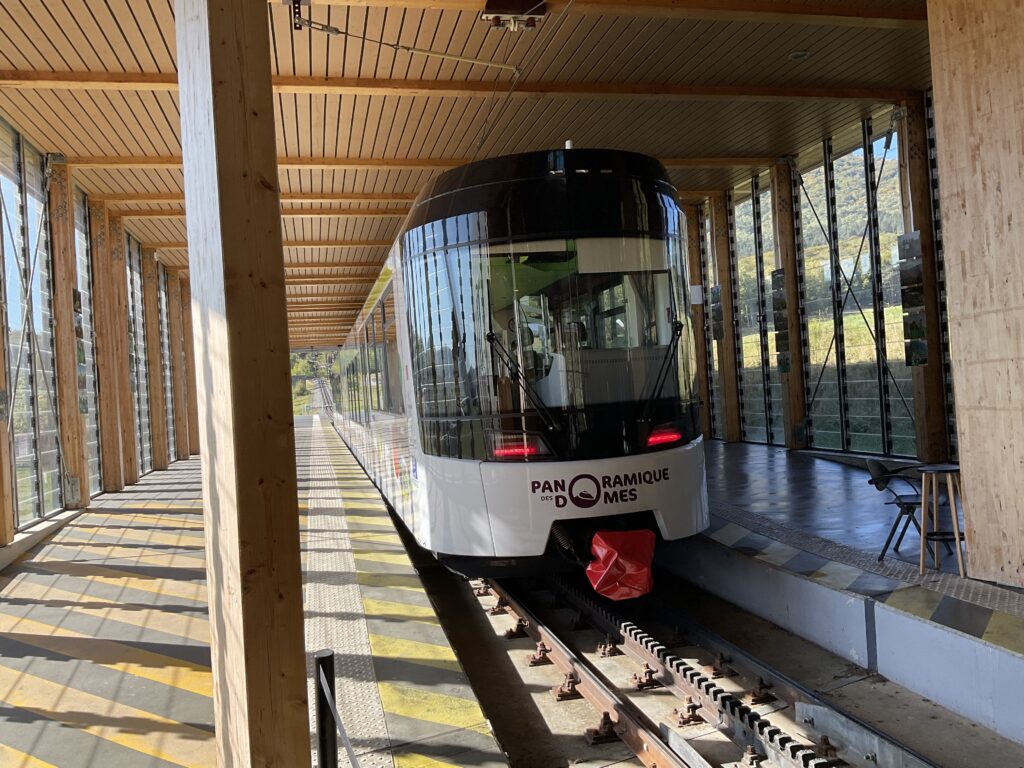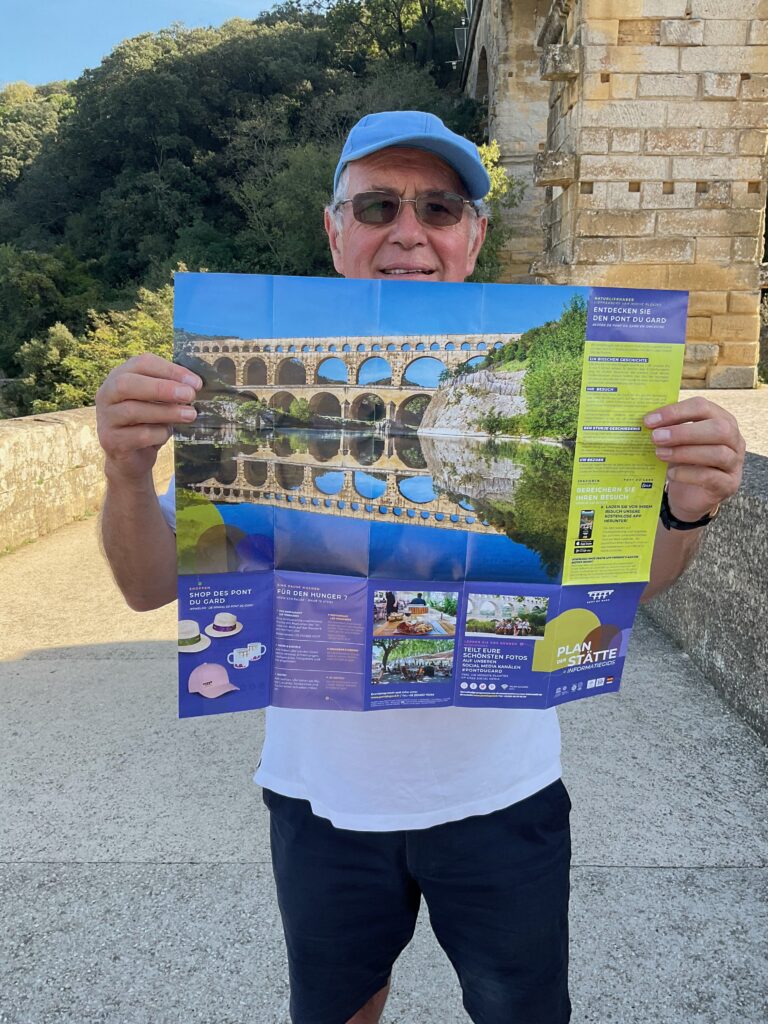Swiss Railways train in Zurich Station
LONDON TO MONTPELLIER
Out the pretty way and back the fast way!
On Wednesday October 13th I took a party of ten on a visit to France that had already been postponed three times because of the pandemic. We had to check in at St Pancras International 90 minutes before departure to allow for some extra formalities, but these were not daunting and at 10.24 our Eurostar left on its non-stop run to Paris. It was comfortably loaded and comparable to pre-pandemic journeys –except that we now had to wear face masks, as we did on all public transport in France.
At Paris Nord we came on to the concourse and headed for the metro – having already purchased metro tickets for the outward and return legs of the trip at the bar buffet on board the train. It was necessary to take metro line 4, changing at Chatelet – Les Halles to line 14, to reach Bercy – a small station which had started life in the 1970s as a motorail terminus but is now used more as an overflow station for the Gare de Lyon. It is not the most convenient of Paris stations – even the metro is two streets away – but is now the starting point for trains to the central Auvergne region.
We sat in the lounge or station garden to consume our drinks and sandwiches before boarding the Inter City train which left at 16.01 for Clermont Ferrand. Soon we were heading south across the flat fields of Ile de France then into the hillier country along the valley of the Loire and then the Allier. A trolley service provided some welcome refreshment and darkness set in after Vichy. Arrival at the modern station of Clermont Ferrand was punctual at 19.29 and we were stating at the Hotel des Commercants, just across the road, where we had a very welcome three-course meal.
Why Clermont Ferrand? It is in the centre of the Auvergne region, noted for its unusual flat topped volcanic hills, the highest of which is the Puy de Dome, 6 miles to the west of the city. The following morning, in bright sunshine, we took a comfortable city bus for some 6 miles into the wooded foothills of the Puy, and transferred to a modern cogwheel railway, opened in 2008, which wound its way up to the bare summit, 4806 feet above sea level. On this clear autumn day we could see across the hills in all directions. Most of us also lunched at the cafeteria in the visitor centre, where we did also have to show proof of our covid vaccination.
Returning to the city, we then sampled the “tramway”, which is powered by overhead wires and guided by a single rail embedded in the road surface. It is almost unique in the world (there are apparently only three others) and has pneumatic tyres – appropriate perhaps for Clermont Ferrand, the home of Michelin which, up to the early 1950s also manufactured rubber-tyred diesel railcars for French railways. The tramway was very busy with city workers and students returning home. We also had some time to view some impressive churches and other historic buildings before a convivial meal back at our hotel.
The morning of October 15th enabled members of the party to explore the ciy centre further on foot, write postcards and purchase food and drink for the next stage of the journey. This began at 12.53 in a 4-car diesel multiple unit branded with the name and logo of the region of Occitanie. The line south of Clermont Ferrand is not (yet?) electrified and is mainly single track, following the winding valley of the Allier for much of its length.
Initially the train was well-filled, but after a few stops we had more space to ourselves and could also enjoy the scenery. The Puys were behind us but the countryside soon became hillier again as we climbed, criss-crossing the river Allier in its gorge, into the Cevennes mountains and then began the gradual descent to Ales. The train was busier now and at 18.02 we drew into Nimes, where we changed to a TER electric train for the last leg to Montpellier. Our hotel was opposite St Roch station, in the centre of his historic city and later that evening members of our party were enjoying an alfresco meal in one of the restaurants of the grand Place de la Comedie on a mild Mediterranean evening.
Montpellier has an impressive modern tram system and we made good use of it during our stay. A day ticket costs just 4,60 Euro, a single is 1,60 and a ten-trip ticket 10.00. There are three long cross-city routes and an orbital route around the central area. After exploring the city centre with its bustling streets and grand cathedral and historic churches, plus an 18th century aqueduct, most of us took the number 3 tram southeastwards through recently built suburbs with out-of-town shopping centres to the large village of Perols, situated between two lagoons and a short distance from the beach. A few minutes’ walk from the Perols Centre tram stop brought us into the historic centre and a small restaurant and an enjoyable open air lunch in the little square.
The rest of our time in Montpellier was spent singly or in groups exploring the city and its surrounding area, in warm and sunny weather for most of the time. On Sunday most of the group headed for Sete, half an hour down the coast by train. There is a port (with a ferry link to Tangier), a network of canals, a beach and a walk up a hill to gain remarkable views of the coast and lagoons. The town is known as the birthplace of the singer Georges Brassens whose centenary has been celebrated this year.
An adventurous group headed to Marseille for a day; while others visited historic Nimes with its well-preserved Roman amphitheatre, and the world-renowned Pont du Gard – a massive aqueduct built by the Romans to bring fresh water to the city. This last excursion included a bus ride from Nimes (where we found the country bus station on the south side of the railway station) to Remoulins, lunch at a snack bar and then another bus to the Pont du Gard, followed by a 15-minute walk.
A memorable evening was spent at a restaurant in the northern suburbs of Montpellier arranged by local rail campaigner Eric Boisseau,who is lobbying for a night train service from Barcelona to Frankfurt via Montpellier; and who also told us about the “Cevenol” diesel express train that used to run over the route that we had used between Clermont Ferrand and Nimes. He sees a future role for tilting trains over this line to reduce journey time.
Two of our party caught the wrong train back to Montpellier on one excursion and were deposited at the new station of Montpellier Sud de France on the high speed line just outside the city, next to the motorway. They had to catch a shuttle bus to Place de France tram stop and then the number 1 tram into the city centre. This new station is sometimes referred to as “la gare des pampas” by local people, but there are plans to extend the tram line to reach it.
Our return journey on Wednesday October 20th was by high-speed TGV from St Roch station at 09.18 and using high speed lines nearly all the way. With only two stops, at Nimes Centre and Valence TGV, bypassing important cities such as Avignon and Lyon, we reached Paris Gare de Lyon on time at 12.50 and used our metro tickets (bought on the way out) for a swift journey on the RER direct to the Gare du Nord.
There was time for lunch, of which several of us partook in cafes or restaurants in the rue de Dunkerque, before crossing the street to the station to check in for the Eurostar. We were advised to allow up to two hours for this, to show documentation such as our pre-booked covid test appointments on our return to the UK. Several of us took our tests at Collinsons on St Pancras International station, after arriving at 18.32 on a well-loaded Eurostar. Indeed, in my case, having been successfully tested, I was on the 19.30 from Liverpool Street at the end of a very enjoyable trip.
It is hoped to arrange a repeat visit in late April or early May 2022.










